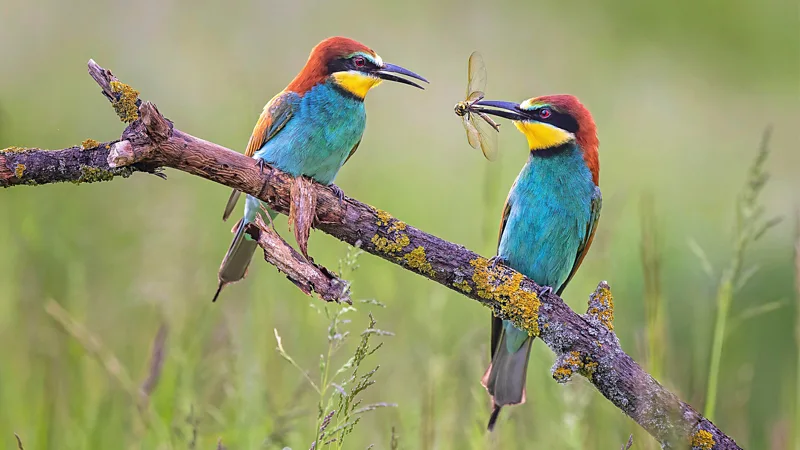The animals that give each other gifts
We may think that gift giving is a purely human trait, but it turns out many other animals also treat their mates and companions.

If on Christmas morning, upon opening your annual gift of novelty socks, your feeling is that of crushing disappointment, you can at least be thankful that you're not a female scorpionfly.
If you were, then the best you could look forward to at yuletide would be a ball of spit from the love of your life. Far from being disappointed though, female scorpionflies relish the tasty treat, rewarding their suitors with the opportunity to mate with them.
Nuptial gift giving – when the male presents the female with a nutritious morsel during courtship and mating – has been noted in species as diverse as snails, earthworms and squid. Birds have been known to enjoy gift giving too, with male great grey shrikes impaling small creatures on thorns and twigs to impress mates, before offering them as presents during courtship.
However, the phenomenon is most common amongst insects and arachnids. Male six-spot burnet moths, for example, give their female partners cyanide delivered via their sperm. Nursery web spiders, on the other hand, present potential mates with prey wrapped up in silk, with added chemicals to make it more attractive. If the female refuses, the male simply adds more wrapping to the gift, before offering it again.
Sometimes the males try to trick the females by wrapping up low-quality prey, or even paltry half-consumed morsels. While the female is busy unwrapping what she thinks is a thoughtful gift, he'll mate with her and run off before she realises. One study found that as many as 70% of gifts given by male nursery web spiders are fake.
"You do get males attempting to cheat. They might wrap up an old, dried-up leg of a cricket, or something," says Darryl Gwynne, a behavioural ecologist at the University of Toronto in Canada.
Other insects have been known to try to skimp on gifts too.
"Down the road from my house in spring there's a really beautiful thing where male dance flies go out over the river and catch aquatic insects," says Gwynne.
"They bring it back, and females compete for the prey because they can't feed themselves, and they need this nutrition to produce their eggs. On one occasion, I saw a male come in with a ball of willow fluff that comes off the willow seed and attempt to present that."
While presenting a worthless gift may benefit the male in the short term, as soon as the female has unwrapped her gift and realises that she has been deceived, she will reject him. This means that he will only get to mate with her for a brief period. As female insects usually mate with several suitors, the dishonest male's sperm will be less likely to fertilise her eggs, meaning he loses out in the long term.
Some insects offer the ultimate gift of self-sacrifice to females they want to woo. During mating, the male sagebrush cricket lets the female nibble on his hind wings, even allowing her to suck out his haemolymph (the insect equivalent to blood). According to one study, once males have endured this "love bite", their chances of finding another partner are slim because they simply lack the energy to pursue other romantic encounters.
The male red back spider, meanwhile, will literally back flip into the female's jaws during copulation, allowing her to chew on the end of his abdomen until he's eventually consumed.
"In one sense, you could say he's harmed because he loses his life," says Wynne.
"But from a Darwinian fitness perspective, finding any female to mate with is such a rare and lucky occurrence in red back spiders, that by performing this back flip and distracting her with a meal, it extends copulation and allows him to get more sperm in. As a consequence, he'll almost certainly get more offspring as a result."
In 2022, entomologist Chufei Tang of China's Jiangsu Academy of Agricultural Sciences and her colleagues even uncovered an example of insect gift-giving preserved in 99-million-year-old amber. Inside the ancient amber, a male fly of the genus Alavesia grasps an empty, frothy balloon made of mucus between his legs.
All these examples are nuptial gifts, given by males to females to convince them to mate. More often than not, these gifts have a nutritional value, so the female benefits too. However sometimes animals have been known to give presents just to please the recipient. For example, dolphins have been observed giving food to people, with offerings including eels, tuna and octopuses. There are also accounts of crows giving presents to humans that have helped them in the past.
"I've received gifts from crows including walnuts, olives, bottle tops from beer bottles, and wine corks," says Nicola Clayton, professor of comparative cognition at the University of Cambridge in the UK.
"Luckily, they haven't given me roadkill, as I'm a vegetarian. I'd much prefer a piece of jewellery."
Eurasian jays, which are members of the crow family, also appear to give gifts to their mates simply for the joy of giving. In one experiment by Clayton and her team, males watched their mates eating either moths or worms. When given the opportunity to give his partner a juicy morsel, the male consistently chose to give his mate the different food. In other words, the males understood that the females would rather have something new than more of the same.
"It's like if you're out to dinner and you've just had a nice spaghetti bolognese," says Clayton.
"If somebody said, 'Do you want another one? 'You'd say, 'No thank you.' But you can manage to find room for a dessert. The jays seemed to know what their partners wanted and could give the right kind of present, independent of what they wanted themselves."
Altruistic gift giving is also common in bonobos, a species of great ape that shares nearly 99% of its DNA with humans. A 2013 study found that bonobos, just like humans, sometimes give presents to strangers in acts of apparent charity. In the case of the bonobos, the apes chose to share food including apples and bananas with other bonobos who weren't a part of their group, even choosing to forego their own food so that they could interact with the stranger.
So, this all begs the question – why do animals give each other gifts? As the behaviour has evolved multiple times across different species, it likely enhances the reproductive fitness of both males and females. This is certainly true in the case of insects and arachnids – except when one party cheats. "He's providing her with a meal, and she's providing him with the access to her reproductive tract," says Gwynne.
But if this doesn't sound particularly romantic, you can take heart from the fact that other animals, such as crows and bonobos, also appear to take pleasure from the simple act of giving.
"In the insect world the male gives the gift so he can mate with the female, but in the jays they pair for life, so it's not it's not a bribe, it's a gift," says Clayton.
"Jays are highly intelligent, long-lived animals, and as you know, attaining a relationship is one thing, but maintaining it over many years is much harder. So gifts are a token of appreciation."
Therefore, in crows like the Eurasian jay at least, the basic drive behind gift-giving is likely the same as in humans – to enhance social bonds with those closest to us. Doesn't that just give you a warm fuzzy feeling, just in time for Christmas?
-BBC






